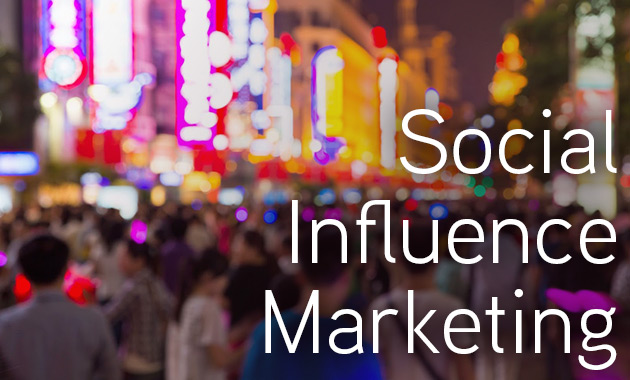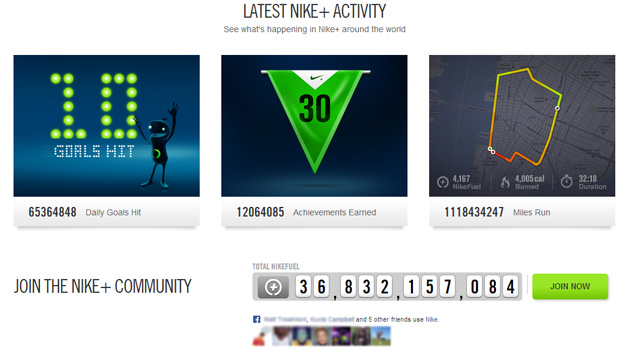Craig Charley
7 Aug 2014
Social Influence Marketing
The psychology of social proof gives marketers an incredible tool for increasing the reach of their content.
We are influenced and we influence others based on the groups we identify with and the content we share online.
Digital marketing can tap into that mentality to increase inbound traffic and drive conversions; Social Influence Marketing.
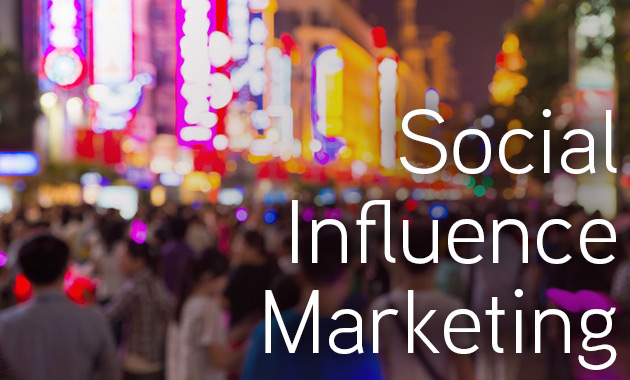
The theory of social influence is excellently explained by Victor Yocco for Smashing Magazine in his article 'Social Influence: Incorporating Social Identity Theory Into Design'.
I recommend reading Victor's post first to understand the theory behind social identity and then come back to find out more about how you can apply it to your own site.
Victor sees great opportunity for designers to enhance websites and products by using social identity theory in the way that Nike has built an entire network around Nike+.
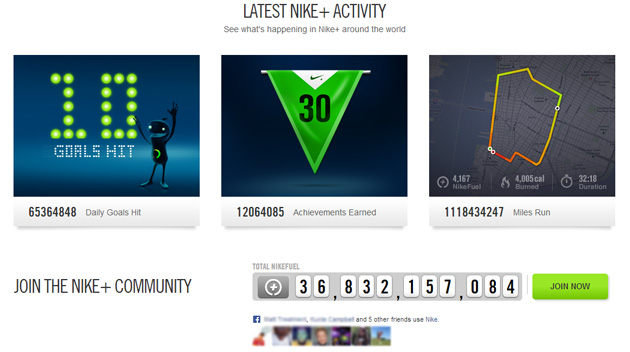
You don't have to build your own social network from scratch to take advantage of social identity theory. It can be as simple as adding sharing buttons to your site.
Social Influence Marketing is simply the use of social signals to increase online reach and improve conversion rates.
Not sure where to start with social media? Create your own effective strategy with Social Media training, part of our comprehensive Digital Marketing training package. It will really help you to improve your outreach skills so that you can start working on social influence marketing!
I believe there are three main social signals to identify; everyone, friends and celebrities.
Signals
Everyone Likes This
"Herd Mentality" - most people want to fit in, and don't want to miss out on something popular.
Use social proof to show how popular a piece of content is - this can be seen in the Nike+ landing page above and also any time a landing page uses the phrase 'xx people use our tool'.
If you have the numbers to show off then do; it's a great way to snowball your content.
People are more likely to engage with content that has a lot of shares and comments; it's exactly how sites like Reddit and Inbound.org operate. The most popular content surfaces to the top.
It's actually Reddit's tagline:

People read the highest rated/most read content.
Conversely, nothing says "ignore" like a page with 0 engagement. If your site is new and your community isn't that big yet - don't shout about it!
There is nothing wrong with having sharing buttons that don't carry a share count. That's less off-putting than a big fat zero.
My Friends Like This
Facebook didn't become one of the largest online ecosystems because of the number of people using it; it grew because everyone's friends were using it.
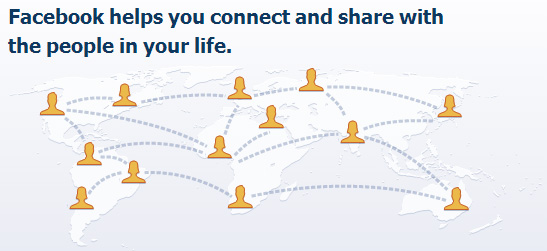
This is possibly the most powerful signal you can use in marketing, and it is one used excellently by companies like Netflix and Spotify.
Both apps users to consume more media based on what their friends have consumed.
What's interesting is that personal connections are perceived as 'votes' for content, even if that's not the case. I might have watched and hated a film on Netflix but my friends will only see that I've watched it and might interpret that as a positive vote.
Using personal connections to promote content also adds an element of gamification. This could be direct competition as in the Nike+ app or even just one people showing off how great their lives are (a driving force behind Facebook!)
To use this on your own site, set your sharing buttons to show friends that have liked/+1'd your content and consider adding a social widget to your landing page that shows visitors which of their friends are using your product.
Celebrities Like This
Not the easiest to achieve, but celebrity endorsements appeal to consumer aspirations. They see that a celebrity they follow uses a product or shared an article and want to emulate them.
Getting approval from celebrities in your niche sends a powerful signal to your audience that you deserve their attention.
Celebrity does not mean the latest star on the front of Heat magazine; it simply means an influence in your niche. This might be a popular blogger or someone with a lot of Twitter followers.
How to Use Social Influence Marketing
Now that you have an idea of the signals that drive social influence marketing, I'm going to concentrate on how you can apply these techniques to your own site.
Reviews
Sitting somewhere between 'everyone' and 'friends' is the importance of consumer reviews, which can make or break a product.
Econsultancy's consumer review stats are telling:
- More reviews lead to higher conversion rates
- 61% of consumers read online reviews before making a purchasing decision
- People trust consumer reviews 12x more than product descriptions.
Nowadays consumers find it very hard to trust a product with no reviews - there's no proof that it works. Reviews can be a key decision maker:

Don't just think of reviews as on-site product reviews - I would also classify a positive comment about a blog post on Twitter as a review.
Reviews are more powerful if there are a lot of them (everyone likes this) and even better if they are by friends of the customer (my friends like this).
Make Social Sharing Easy
Put social buttons and calls to action in the most obvious place and make it a simple process.
Common placements include the top, bottom and side of the page.
Personally I can't stand floating sidebar buttons as I feel like they're following me around shouting 'share me, share me' and it puts me off the content but it does work well on some sites when designed well.
Make sharing a one or two click process and don't make visitors connect with you first. If they like your content that much they will make the effort themselves.
Our buttons sit at the top of the page and give two options. Vote using a like or +1 or Share on Facebook, Twitter, Google+ and LinkedIn.

You should also prefill sharing widgets to make the actual share as engaging as possible. With the Tweet button you can set the Tweet to automatically include both your brand and the author of the blog post.
You can also use Open Graph tags and Twitter Card tags to make shared links really stand out in timelines. I go into this in more detail later on in the post.
Right Time, Right Place
Good luck finding the share buttons on an Amazon product page (they're hidden below the right hand sidebar if you were wondering).
However, Amazon does prompt you to share when you've purchased a product.
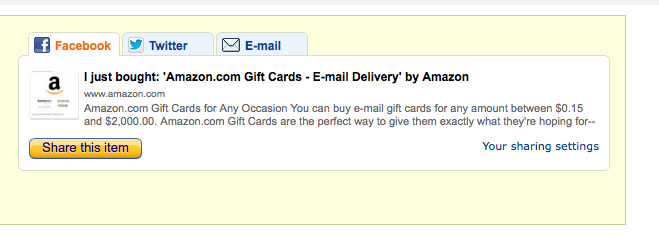
Credit: Smashing Magazine
They understand that when you're browsing you're not in sharing mode. But when you've bought something you've chosen and you're ready to tell people about it.
This is a great way to encourage the 'my friends like it' signal.
Something they could consider is to add a share option after you post a review, I was surprised that there isn't an option for this.
Think of intent when deciding when and where to place your social calls to action to encourage engagement.
Don't Overload your Site with Buttons
Choose one, clear, obvious place to put your social sharing buttons and stick to one function.
You don't need top, bottom and floating side buttons and you don't need to have both a 'like' and a 'share' button for every network you can think of.
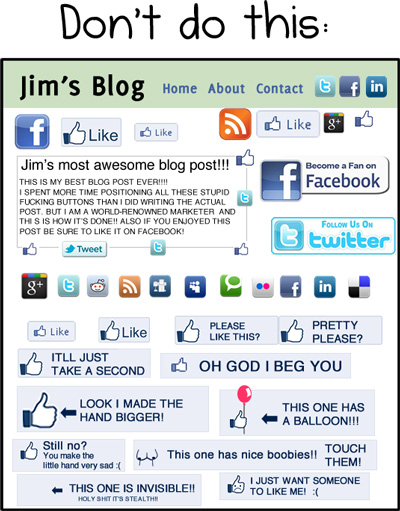
Overloading your site with social sharing buttons does not encourage more sharing.
Give the user too much choice, or confuse them, and they simply won't bother.
Not Every Page Needs Buttons
When was the last time you saw someone share an about us or contact page?
Probably never, and yet plenty of sites give you the option - why?
Social share buttons add nothing to many times of pages except visual clutter and confusion for the user.
"Why does this website want me to share their company history?"
There are some exceptions to this rule. For example, you have an interesting and exciting company history and you create an interactive experience around your story.
If you're wondering which pages should not have share buttons ask yourself two questions - Would I share this? Would I click on this if someone else shared it?
Two no's, remove the buttons!
Often the buttons are only there because someone forgot to turn them off.
Most WordPress sharing plugins give you the option to turn off social buttons for certain pages, or if you have a custom CMS ask your developer to give you the option to specify which pages have buttons.
Social Commenting
Your comment system can be a great way to build up a social group on your site.
Use Facebook, Google+ or Disqus comment systems which allow users to log in using a social account.
In the case of Facebook and Google+ this expands the conversation off your site onto those networks - further increasing the reach of your content and the conversation.
Buzzfeed does this very well. When you go to post a comment by default your comment is shared through your Facebook profile.
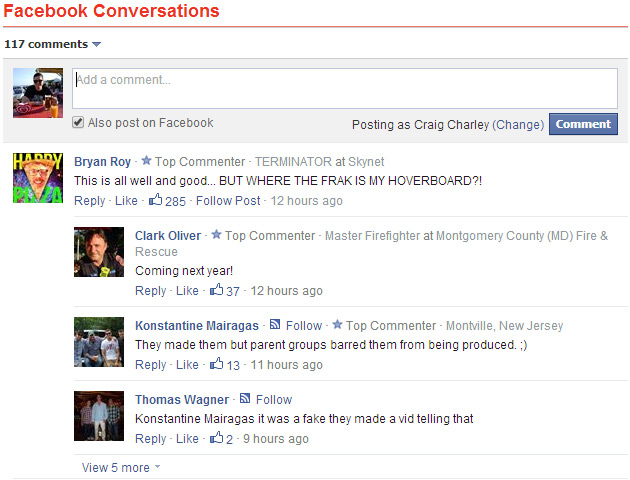
Your friends can then directly reply to your comment through Facebook without even having to read the article.
The result? Buzzfeed articles receive hundreds of comments and every one increases their reach on Facebook.
Unsurprisingly, Facebook is their top source of traffic:
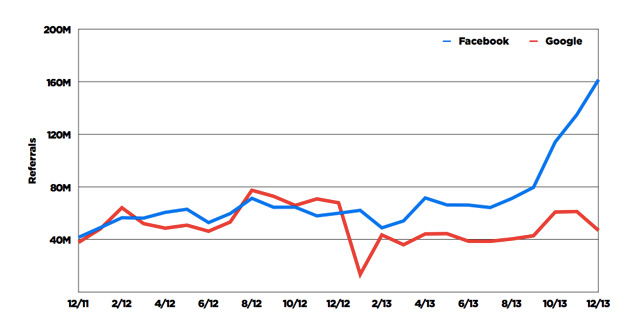
Make sure that your comments section is a social place - respond to commenters quickly and keep the conversation flowing with further questions.
Don't have an open comment policy - make sure to remove spam and abusive comments.
Only a few sites can get away with unmoderated comments that allow personal abuse and swearing.
Think of your comments section as a social club for your audience - how can you make it as comfortable and welcoming as possible?
Choose the Right Platforms
You can't build a presence on every social network and bookmarking site so it's important to choose the right ones to focus on.
Stick to the networks that your audience uses. If your site is aimed at kids then don't waste your time with a LinkedIn button.
Facebook, Twitter and Google+ are all safe bets, but it is always worth doing your research to find out where your audience is most likely to share your content and promote those channels.
Outreach
Social influence marketing relies on the signals being in place to get the ball rolling. But simply creating something won't gain those initial shares or even a 'celebrity' endorsement.
After publishing content or releasing a product get hard to work on outreach. Make sure your immediate circles see it and share it. Get in touch with influencers and ask for an endorsement.
If the content is good enough then people will share and won't mind being bothered. Just be courteous and make sure the content meets expectations.
Struggling to get your content shared? Read Carson Ward's post 'Is Your Content Credible Enough to Share?'
Open Graph
To get the most out of social sharing and encourage clicks from shared content then it is vital to add open graph tags to your pages.
These are meta tags that give social platforms the content to use when a link is shared. If you don't use open graph tags then Facebook & Google+ will pull data from the content itself which should be optimised for search not social.
Basic open graph tags include:
- og:title - The title of your object as it should appear within the graph, e.g., "The Rock".
- og:type - The type of your object, e.g., "video.movie". Depending on the type you specify, other properties may also be required.
- og:image - An image URL which should represent your object within the graph.
- og:url - The canonical URL of your object that will be used as its permanent ID in the graph, e.g., "http://www.imdb.com/title/tt0117500/".
- og:description - A one to two sentence description of your object.
- og:video - A URL to a video file that complements this object.
Get your developer to add these tags to your page template so that you have the option to set the title, image and description for each page. Customise these to make them more clickworthy - you don't have to think about keywords, just clicks!
Here's a post we recently shared from HBR:
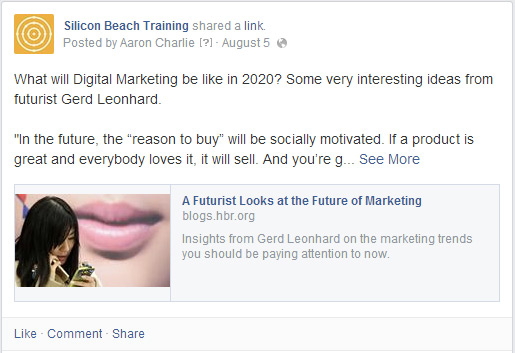
Notice that the description in the link does not appear anywhere on the page. That's because it's from the og:description tag.
You should also add additional meta tags for Twitter cards. Read out full write up of the types of Twitter cards and how to add them to your site.
Summary
People are heavily influenced by social signals. Use them effectively and you will see shares rocket and conversion rate increase.
Target the three signals:
- Everyone likes this
- My friends like this
- Celebrities like this
Choose your method carefully and tailor it to your audience.
If they are heavy Facebook users then use Facebook login, Facebook comments and add widgets that show which friends are using your site.
Use tags to customise how your links appear when shared.
Most importantly of all, use your existing network and influencer relationships to get the ball rolling.
Do you have any amazing examples of social influence marketing? Or even better, terrible examples? We'd love to hear about them.
Don't forget to check out our full range of Digital Marketing courses.
